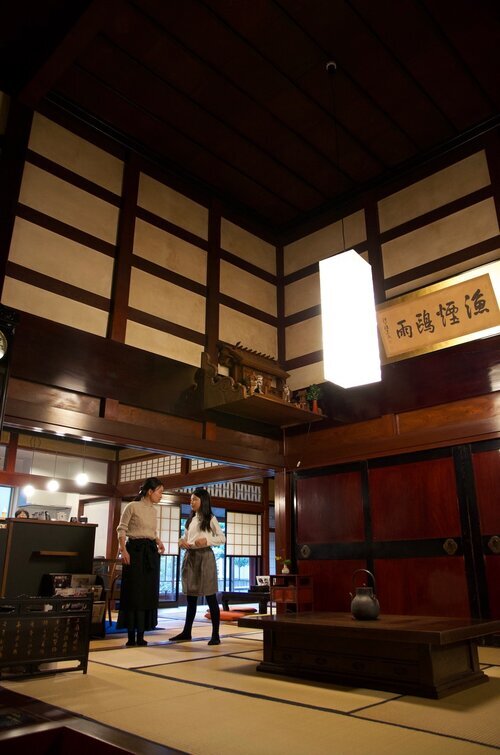Himi, At Last
A complex of old, thatched-roof farmhouses in the mountains outside of Tokamachi. Photo Credit: Nina Noah.
After a beautiful trip into the mountains and then a long trek from Tokamachi, which involved changing trains three times, we arrived in Himi late last Tuesday. We awoke on Wednesday morning, ready to work, arriving at Bansho san’s workshop at 7:45am. We were pleasantly surprised to find ourselves whisked into Bansho san’s car to spend the day touring Himi. We visited the Himi cultural museum, where there is an exhibit all about the traditional boats of the area. The exhibit included several beautiful boat models Bansho san had made, like this one of the tenmasen, the boat we are building with him.
A model of the tenmasen built by Bansho san. Photo Credit: Nina Noah.
We drove up into the hills for a view of the city.
The city of Himi, as seen from above. Photo Credit: Ben Meader.
We walked part of the way back down, passing through the gardens of an abandoned Buddhist temple.
The temple is made from beautifully carved and painted wood. Though it has been abandoned, there are still volunteers who continue to care for the structure and grounds. Photo Credit: Nina Noah.
Douglas underneath a giant Gingko tree near the temple. Photo Credit: Ben Meader.
Bansho san treated us to a lunch of “Himi Udon” nearby the workshop, and then we hit the road again to visit museum storage in a repurposed elementary school the next town over. The old gymnasium was jam-packed with boats - a half scale dobune built by Bansho san and launched last year, a few tenmasen, a selection of rice field boats or tabune, a boat from North Korea that had drifted over to the coast of Himi, a sappabune or bamboo leaf boat from Toyama, and even a whitehall, built years ago for a local boat rental.
The half scale replica of a dobune recently completed by Bansho san. These boats were used for tending large set nets but have now been replaced by a similar boat made of fiberglass. Photo Credit: Douglas Brooks.
We visited Ai san, a friend of Douglas’ who’s a local shoemaker.
Wasen shoes made out of fish leather (yellowtail) and wood. Photo Credit: Douglas Brooks.
And we went for an afternoon coffee at a beautifully restored building dating back to the early 1900s that had been recently turned into a cafe.
The name of the cafe, Hikoemon, is a family name. Photo Credit: Nina Noah.
The seating area looks out onto a small courtyard garden. Photo Credit: Nina Noah.
Two of the cafe proprietors. The building has been in their family for over 100 years. They used to spend vacations here but decided to move to Himi two years ago and open the cafe. Photo Credit: Douglas Brooks.
Last Thursday, we began work on the tenmasen. The tenmasen is a much more complex boat than the honryousen we built with Nakagawa san. It’s roughly 13 feet long, with a beam of 4 feet. The boat resembles a flat bottom skiff - it has a stem, transom, a keel plank, and two side planks.
Point bending the keel plank. We cut a 10mm saw kerf in the top of the plank and then used a bottle jack to lift the stern. Photo Credit: Ben Meader.
The backbone pieces of the tenmasen: the stem, transom, and keel plank. The stem is directly mortised into the keel plank. Photo Credit: Douglas Brooks.
Douglas fitting the transom joint with a saw. Photo Credit: Ben Meader.
Unlike most western boats, however, the stem isn’t rabbeted to receive the planking. Instead, the planks lay against the sides of the stem and the konagashi, two triangular-shaped pieces that create a boxlike structure at the base of the stem. This means that the garboard plank doesn’t need to twist to vertical to meet the stem.
The two konagashi are ready to be fastened into the stem and keel plank. Photo Credit: Nina Noah.
We’ve enjoyed working with Bansho san so far. Despite being over 70 years old, he is energetic, working quickly and confidently, cracking jokes from time to time with an impish grin. After one week, we’ve assembled the backbone and are preparing the garboards, which we’ll hopefully get fastened on next week.
Douglas, Bansho san, and Ben in action. Photo Credit: Nina Noah.















